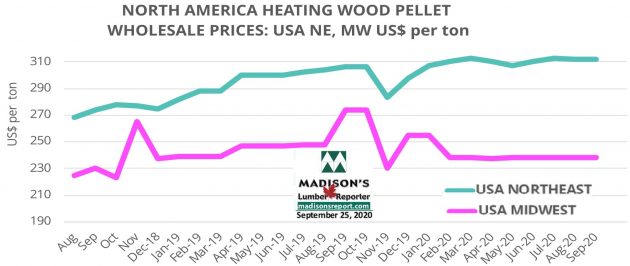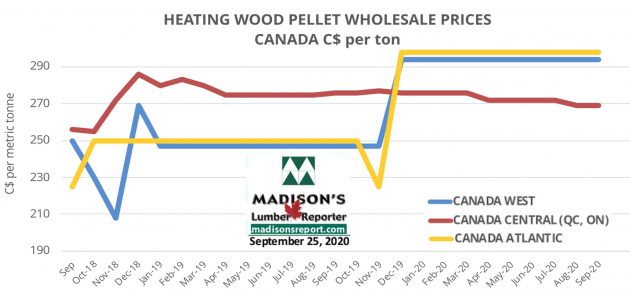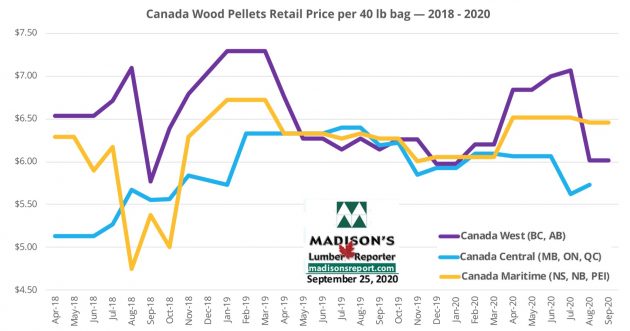
Latest data projections, industry expansion show wood pellet consumption expected to continue growing
October 16, 2020
By Madison's Lumber Reporter

Biocarbon pilot plant coming to Quebec
Norway-based chemical industry company Elkem plans to build a new biocarbon pilot plant near Chicoutimi, Que. The total investment cost for the plant will be roughly $26 million, but with financial support from the Canadian government, the Quebec government, and the city of Saguenay, Elkem’s net investment will be $8.7 million. Construction of the pilot plant is slated to begin sometime in the second half of 2020, with Elkem aiming to evaluate the basis for a full-scale plant from the performance of the pilot. The facility will test an industrial biocarbon process for producing silicon and ferrosilicon products, with the reduction agent coming from climate-neutral renewable biocarbon rather than fossil coal. Feedstock for the reduction process will be derived from local sawmills in the region, including recycled bark, wood chips, sawdust, and wood shavings.
Grant turns residual forest fibre into pellets
British Columbia-based Pinnacle Renewable Energy has received funding from the Forest Enhancement Society of BC (FESBC) to ensure that residual fibre from forest operations in the Bulkley Timber Supply Area is utilized. A $1.2 million grant from FESBC will be used to cover hauling costs so that the forest waste will be delivered to Pinnacle’s biomass plant in Smithers, B.C., to be made into wood pellets rather than being piled and burned in the forest. In addition to improving air-quality by avoiding burning residual fibre, using the raw material to create a marketable product provides an end destination for pulp logs and bio-logs that would otherwise create a waste-management headache for licensees. Through the funding, Pinnacle is recovering nearly 90,000 cubic metres of fibre that will be densified into pellets and used for renewable power generation in multiple global energy markets.
Hydroelectric project waste wood to be made into pellets
The construction of the 824 MW Muskrat Falls hydroelectric project in Labrador, Canada, created a significant amount of waste wood in the form of felled trees. That fibre is now being chipped and shipped to biomass manufactories in Europe and the United States. A partnership between the Innu Nation of Labrador and JP Forestry Environmental will create 70 jobs through a two-phase harvesting plan. Phase one will involve the chipping of 400,000 cubic metres of wood cut between 2013 and 2015, while the second phase will entail an ongoing harvest of 185,000 cubic metres annually.
2020, 2021 bioenergy forecasts in from EIA
The U.S. Energy Information Administration’s latest Short-Term Energy Outlook (STEO) predicts increasing electricity generation from renewable energy sources in 2020 and 2021. Power from renewable sources is anticipated to rise from 17 per cent in 2019 to 20 per cent by the end of 2020, before advancing another two per cent to 22 per cent in 2021. Biomass is expected to generate slightly less energy in the electric power sector this year, down 2.4 per cent from 28.8 billion kWh in 2019 to an estimated 28.1 billion kWh in 2020.
According to the STEO, biomass generation capacity in the electric power sector is anticipated to decrease 0.6 per cent from 6,672 MW in 2019 to 6,628 MW in 2020. For 2021, biomass generation capacity is forecast to rise slightly to 6,638 MW. In the electric power sector, the proportion of biomass power generation is split roughly 45:55 between wood biomass capacity and waste biomass capacity. Across other sectors, biomass power capacity is expected to inch up from 6,424 MW in 2019 to 6,428 MW in 2020 and remain steady into 2021. In other sectors, the proportion of biomass power generated by wood biomass capacity and waste biomass capacity is approximately 85 per cent and 15 per cent respectively.
Print this page


